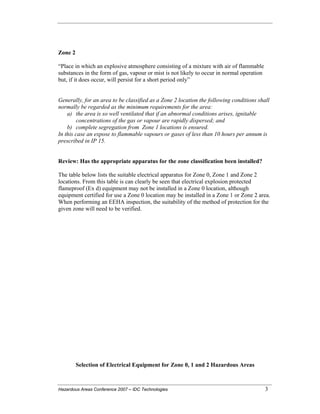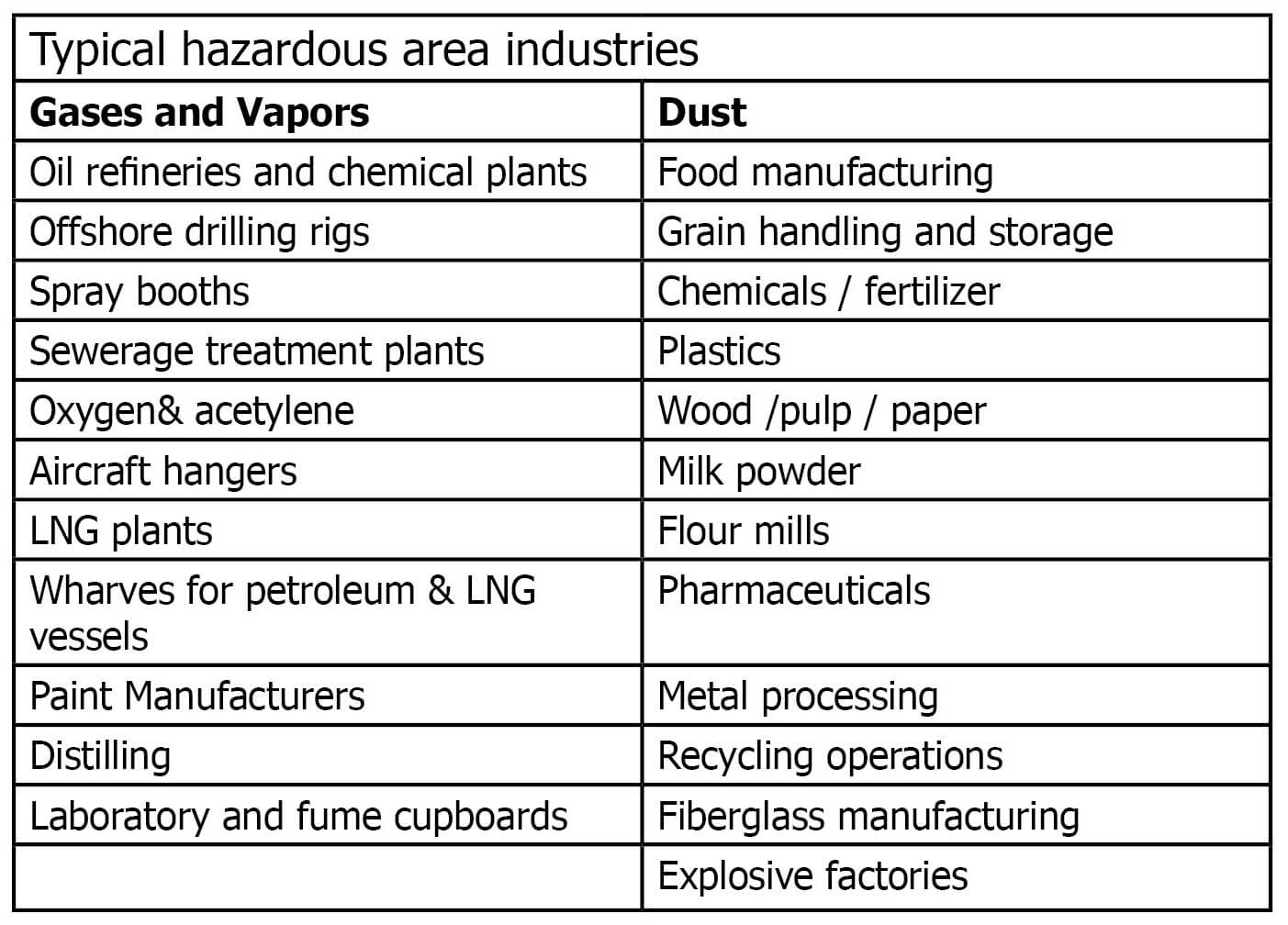Excitement About Roar Solutions
Excitement About Roar Solutions
Blog Article
Facts About Roar Solutions Uncovered
Table of ContentsSome Known Questions About Roar Solutions.See This Report about Roar SolutionsThe Facts About Roar Solutions Uncovered
In such an environment a fire or surge is feasible when 3 basic problems are satisfied. This is commonly referred to as the "harmful location" or "combustion" triangle. In order to secure installments from a possible surge a technique of analysing and classifying a possibly dangerous area is required. The objective of this is to make sure the correct selection and setup of equipment to ultimately prevent an explosion and to guarantee safety and security of life.
(https://justpaste.it/8xypx)
No devices ought to be set up where the surface temperature level of the equipment is higher than the ignition temperature of the provided threat. Below are some usual dust harmful and their minimal ignition temperature level. Coal Dust 380C 225C Polythene 420C (thaws) Methyl Cellulose 420C 320C Starch 460C 435C Flour 490C 340C Sugar 490C 460C Grain Dirt 510C 300C Phenolic Resin 530C > 450C Aluminium 590C > 450C PVC 700C > 450C Residue 810C 570C The likelihood of the danger being existing in a concentration high sufficient to cause an ignition will certainly vary from place to area.
In order to classify this risk an installment is split right into areas of risk relying on the amount of time the unsafe exists. These areas are described as Areas. For gases and vapours and dusts and fibers there are three zones. Area 0 Area 20 A dangerous environment is extremely most likely to be present and may be present for lengthy periods of time (> 1000 hours annually) and even constantly Zone 1 Area 21 A hazardous environment is feasible yet not likely to be existing for extended periods of time (> 10 450 C [842 F] A classification of T6 indicates the minimum ignition temperature level is > 85 C [185 F] Hazardous area electric devices possibly created for use in greater ambient temperatures. This would certainly showed on the score plate e.g. EExe II C T3 Ta + 60C( This means at 60C ambient T3 will certainly not be exceeded) T1 T1, T2, T3, T4, T5, T6 T2 T2, T3, T4, T5, T6 T3 T3, T4, T5, T6 T4 T4, T5, T6 T5 T5, T6 T6 T6 A T Class ranking of T1 indicates the maximum surface temperature level generated by the instrument at 40 C is 450 C. Assuming the linked T Course and Temperature score for the devices are ideal for the location, you can constantly use a tool with an extra rigid Division score than needed for the location. There isn't a clear solution to this question unfortunately. It actually does rely on the sort of equipment and what repairs require to be executed. Equipment with particular test treatments that can't be executed in the field in order to achieve/maintain third celebration score. Must return to the manufacturing facility if it is before the equipment's solution. Area Repair By Authorised Personnel: Complex testing might not be needed nonetheless details procedures might need to be adhered to in order for the devices to keep its 3rd event rating. Authorized workers must be employed to carry out the job appropriately Repair service need to be a like for like replacement. New part have to be considered as a straight substitute needing no unique screening of the tools after the repair is complete. Each item of tools with a dangerous rating should be evaluated individually. These are outlined at a high degree listed below, yet for more thorough information, please refer straight to the standards.
An Unbiased View of Roar Solutions
The devices register is a thorough data source of devices records that includes a minimum collection of areas to identify each thing's place, technical parameters, Ex category, age, and ecological data. This info is crucial for monitoring and taking care of the devices properly within harmful areas. On the other hand, for routine or RBI tasting inspections, the grade will be a combination of Detailed and Close assessments. The ratio of Comprehensive to Close evaluations will be established by the Equipment Danger, which is evaluated based upon ignition threat (the chance of a source of ignition versus the probability of a flammable environment )and the harmful area classification
( Zone 0, 1, or 2). This variation will certainly likewise influence the resourcing needs for work preparation. As soon as Great deals are defined, you can establish sampling plans based on the sample size of each Lot, which describes the variety of random tools things to be checked. To determine the needed sample size, two elements need to be assessed: the dimension of the Great deal and the classification of evaluation, which suggests the level of effort that need to be used( lowered, typical, or enhanced )to the inspection of the Whole lot. By integrating the group of examination with the Great deal size, you can then develop the appropriate rejection criteria for an example, indicating the allowed number of malfunctioning products found within that sample. For more information on this procedure, please describe the Energy Institute Standards. The IEC 60079 common recommends that the optimum period in between assessments ought to not exceed 3 years. EEHA examinations will likewise be performed outside of RBI projects as part of scheduled upkeep and devices overhauls or fixings. These inspections can be credited towards the RBI example sizes within the influenced Great deals. EEHA assessments are conducted to identify faults in electric equipment. A weighted scoring system is essential, as a single piece of equipment may have multiple faults, each with varying levels of ignition danger. If the mixed score of both inspections is less than two times the mistake score, the Great deal is considered appropriate. If the Lot is still thought about undesirable, it should undergo a complete examination or justification, which may cause more stringent examination methods. Accepted Whole lot: The root causes of any type of mistakes are recognized. If a common failure mode is discovered, extra tools may need maintenance. Mistakes are classified by extent( Safety, Stability, Home cleaning ), guaranteeing that immediate problems are evaluated and attended to without delay to minimize any kind of influence on safety or procedures. The EEHA database should track and tape-record the lifecycle of faults in addition to the restorative activities taken. Applying a robust Risk-Based Assessment( RBI )technique is vital for guaranteeing conformity and safety in managing Electrical Equipment in Hazardous Areas( EEHA) (Roar Solutions). Automated Fault Rating and Lifecycle Monitoring: Easily take care of mistakes and track their lifecycle to boost inspection accuracy. The introduction of this support for risk-based assessment better strengthens Inspectivity's placement as a best-in-class solution for regulatory conformity, as well as for any type of asset-centric inspection usage case. If you want discovering more, we welcome you to request a demo and find how our option can change your EEHA monitoring procedures.
Some Of Roar Solutions

In regards to eruptive risk, an unsafe area is an environment in which an eruptive atmosphere exists (or may be anticipated to be existing) in quantities that need special safety measures for the building, installation and use tools. eeha training. In this write-up we explore the challenges faced in the workplace, the risk control procedures, and the required proficiencies to function safely
These compounds can, in particular problems, create explosive environments and directory these can have major and awful consequences. Many of us are acquainted with the fire triangular eliminate any kind of one of the three aspects and the fire can not take place, but what does this mean in the context of unsafe locations?
In many circumstances, we can do little concerning the degrees of oxygen in the air, however we can have substantial influence on sources of ignition, for instance electrical equipment. Dangerous areas are recorded on the harmful location category illustration and are identified on-site by the triangular "EX-SPOUSE" indicator. Below, among various other key information, zones are divided right into three types depending on the risk, the possibility and duration that an eruptive environment will certainly exist; Zone 0 or 20 is considered the most unsafe and Zone 2 or 22 is considered the least.
Report this page